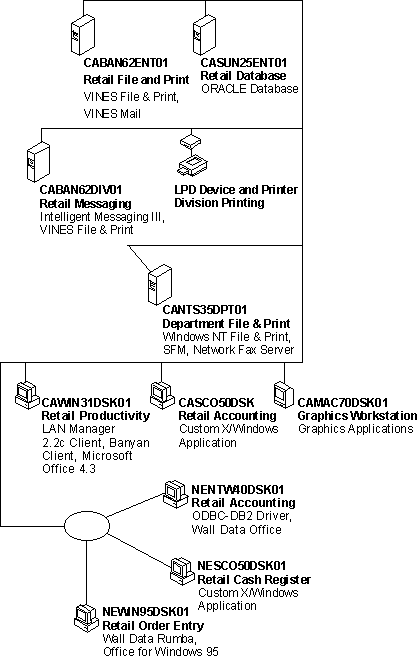
Because the Retail Services division grew by purchasing other florist shops, the division acquired those shops' computer equipment and software systems as part of the purchases. That computer equipment was then incorporated into the division's network.
The network diagram below provides a representation of the computer equipment running in the Retail Services division.

Figure 4.2 Retail Division network diagram before company-wide consolidation
The retail division was relatively slow to computerize. The division purchased the Sun server, currently named CASUN25ENT01, early in the 1980s. Custom applications were written, which are still updated and further customized as needed.
Distribution was incorporated into the Retail Services divisional operations when the distribution center in Dallas was purchased. A Banyan server was obtained as part of that purchase, which provides file and print services to the division.
This server runs the Solaris SPARC version 2.5 operating system. The ORACLE database focuses on retail sales information, with emphasis on distribution and inventory information. Customized business application systems on the Sun server include an inventory-management system, accounting system, customer-ordering system, product-ordering system, point-of-sale application (including a custom exchange rate application to calculate the monetary differences in international customer orders and purchases), distribution software, and delivery-truck scheduling.
The Banyan server runs a Banyan VINES 6.22 network operating system. The server provides file and print services to the Retail Services division headquarters in Sacramento. Banyan mail messaging is provided through Beyond Mail.
Whenever Terra Flora purchased a retail store, the store was connected to the Sun server and then given access to appropriate information stored on the server. The retail stores are provided file and print services for management reports and sales tickets through printers on site in the stores.
The business processes in Retail Services fall into two categories: dealings with consumers and dealings between the distribution centers and the retail stores.
1. The retail store receives customer orders in a number of ways:
2. Except for orders taken over the 1-800 lines, customer orders are entered into the system on the SCO computer, named CASC050DSK, which appears on the network diagram in the California domain at the Desktop level. This entry is made through an X/Windows front-end application. Orders that come in on the 1-800 phone line are entered on the SCO computer by the customer-service representative at the time the order is placed, while the customer is still on the phone.
3. The order data is posted to an ORACLE database running on the Sun server. This automatically triggers a division-wide examination and analysis of inventory and delivery schedules, and then triggers other business applications on other computers to perform the following functions:
4. Standard accounting information is posted to the accounting database as a result of the customer order.
5. Automatic product orders are generated based on sales of product. The store manager reviews the order, accepts or changes the information on the order, and faxes the order to the proper distribution centers.
6. Delivery-truck schedules are produced and printed on local printers at the retail stores that are responsible for delivering customer orders.
The Retail Services division is also responsible for the distribution of product from the distribution centers to the retail stores.
1. Each day, the ORACLE product-ordering database records the product received at the distribution center.
2. Distribution schedules are printed at corporate headquarters and the distribution sites, indicating which retail stores are to receive what products, based on the product orders submitted by the retail stores.
3. New product orders from the retail stores arrive by fax or telephone.
4. The product orders are entered into the ORACLE database on the Sun server.
5. Inventory is examined. If the products ordered are in stock, inventory is updated, product pick tickets are generated, and correct shipping labels and customs documents are printed at the proper printers in the distribution centers.
6. Accounting information in the ORACLE database is updated, as appropriate.
7. Orders for the flower products to be distributed are automatically generated and tracked in the ORACLE product-order database and then faxed or phoned to the proper nursery in the Nursery Products division or to the plant in the Supply and Manufacturing division.